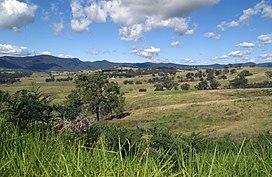| Lowland Grassy Woodland in the South East Corner | |
|---|---|
 | |
| Ecology | |
| Realm | Australasia |
| Biome | Temperate grasslands, savannas, and shrublands |
| Borders | |
| Geography | |
| Area | 0.1 km2 (0.039 sq mi) |
| Country | Australia |
| Elevation | 10–500 metres (33–1,640 ft) |
| Coordinates | 35°12′S 150°26′E / 35.2°S 150.43°E |
| Climate type | Oceanic climate (Cfb) |
| Soil types | Clay |
The Lowland Grassy Woodland, or the Illawarra and South Coast Lowland Grassy Woodland is a grassland-savannah community mostly found in the South Coast region of New South Wales, Australia. Stretching from the southern parts of the Illawarra in the north to the South East Corner in the south, it is an endangered ecological community that lies in a rain shadow area.[1]
Geography
[edit]The community lies in an area that receives less rainfall than the elevated terrain that partly encircle them, with mean annual rainfall generally in the range of 700 to 1,100 mm (28 to 43 in). The community sits on granitic substrates (e.g. adamellites, granites, granodiorites, gabbros, etc.) but may also be found on locally precipitous sites and on acid volcanic, alluvial and fine-grained sedimentary substrates. They generally consist of an open tree canopy, a near-uninterrupted groundcover dominated by grasses and herbs, sometimes with stratums of shrubs and/or small trees. The bioregion incorporates: Bega Dry Grass Forest and Candelo Dry Grass Forest.[1]
The ecoregion is found in the Bega Valley, Eurobodalla and Palerang Local Government Areas, with major presence to the west of Batemans Bay, close to Moruya, in the Araluen valley, Cobargo, Candelo, the Towamba Valley and near Tanja. The remaining environment of the community is gravely fragmented, with more than 95% of surviving patches estimated to be less than 10 ha.[2]
Ecology
[edit]The grassy woodland is dominated by Eucalyptus tereticornis, Eucalyptus globoidea, Angophora floribunda, Eucalyptus melliodora, Eucalyptus pauciflora, Eucalyptus baueriana, Eucalyptus bosistoana, Eucalyptus maidenii and Eucalyptus viminalis. The understorey frequently features small trees like, Acacia mearnsii, Acacia implexa, Exocarpos cupressiformis and a shrub layer that features, Bursaria spinosa, Cassinia spp. and Ozothamnus diosmifolius.
The groundcover features, Themeda australis, Microlaena stipoides and Eragrostis leptostachya, in addition to forbs such as Dichondra repens, Desmodium varians, Hydrocotyle laxiflora, Hypericum gramineum, Glycine clandestina and Cheilanthes sieberi.[3]
Animals
[edit]Inhabitants of the grassy woodlands include Macropus robustus, Macropus parma, Thylogale thetis, Bettongia gaimardi, Dasyurus viverrinus and Phascogale tapoatafa.[1]
References
[edit]- ^ a b c Lowland Grassy Woodland in the South East Corner Bioregion - endangered ecological community listing NSW Department of Planning and Environment. Retrieved 14 September 2022.
 Text was copied from this source, which is available under Creative Commons Attribution 4.0 International License.
Text was copied from this source, which is available under Creative Commons Attribution 4.0 International License.
- ^ Lowland Grassy Woodland in the South East Corner Bioregion - profile Office of Environment & Heritage. Retrieved 14 September 2022.
- ^ Illawarra and south coast lowland grassy woodland ecological community: listing assessment consultation guide Department of the Environment, March 2016. Retrieved 14 September 2022.
Well, that’s interesting to know that Psilotum nudum are known as whisk ferns. Psilotum nudum is the commoner species of the two. While the P. flaccidum is a rare species and is found in the tropical islands. Both the species are usually epiphytic in habit and grow upon tree ferns. These species may also be terrestrial and grow in humus or in the crevices of the rocks.
View the detailed Guide of Psilotum nudum: Detailed Study Of Psilotum Nudum (Whisk Fern), Classification, Anatomy, Reproduction